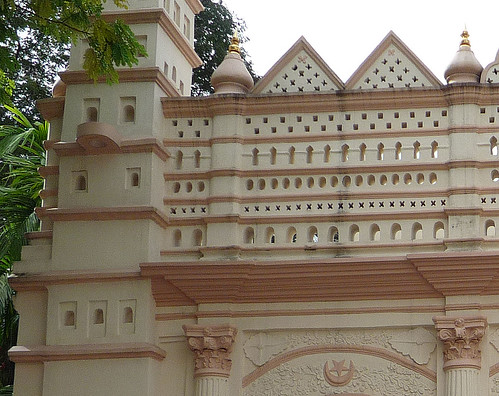Nagore Durgha: Turning Heads Since 1830
(This article was first published in National Heritage Board's yesterday.sg on 20 January 2009.)
If you can't see my photo stream (below), visit my flickr album.
What makes the Nagore Durgha building a National Monument? Is its long history since 1830 a reason? Or is there another head turning reason? I chanced upon this building when I tried something new by exploring the places around Chinatown, instead of just doing the pre-Lunar New Year sightseeing and shopping ritual.
What is so unique about the Nagore Durgha to deserve the label of a National Monument? Nothing. I knew nothing about the Nagore Durgha when I first laid eyes on it. What has changed over the years? Nothing much. Until I checked out the National Heritage Board’s publication, “Singapore’s 100 Historic Places”.
Gazetted as a National Monument on 29 November 1974, Nagore Durgha was the building of religious and cultural importance for the Chulias, who originated from South India along the Coromandel Coast in the 1820s.
(This article was first published in National Heritage Board's yesterday.sg on 20 January 2009.)
If you can't see my photo stream (below), visit my flickr album.
What makes the Nagore Durgha building a National Monument? Is its long history since 1830 a reason? Or is there another head turning reason? I chanced upon this building when I tried something new by exploring the places around Chinatown, instead of just doing the pre-Lunar New Year sightseeing and shopping ritual.
What is so unique about the Nagore Durgha to deserve the label of a National Monument? Nothing. I knew nothing about the Nagore Durgha when I first laid eyes on it. What has changed over the years? Nothing much. Until I checked out the National Heritage Board’s publication, “Singapore’s 100 Historic Places”.
Gazetted as a National Monument on 29 November 1974, Nagore Durgha was the building of religious and cultural importance for the Chulias, who originated from South India along the Coromandel Coast in the 1820s.
I was intrigued by this building (photo above) when I walked past 140, Telok Ayer Street recently. This detour was made before visiting Chinatown. I took photographs of parts of Nagore Durgha which attracted my interest even as I did not know much about it at that point in time.
Anything that still stands in Singapore since its construction in 1828 to 1830, must have a solid history as long as its existence. The owners must also be really passionate people who believe in what they have built, to protect their building against the elements and the changing landscapes.
I shall not bore you with details about its history today. Even the book that I have been reading is clear in its brevity. “The Chulias originally built Nagore Durgha not as a mosque but as a shrine ...”. You’ll have to dig up history books to find out why that was so as the book reveals little else. Perhaps someone knowledgeable can enlighten everyone on this point.
What I do wish to point out is the Nagore Durgha’s unique photogenic architecture. At eye level, its main frontage reveals a classical-styled facade. On top of this is an Islamic balustrade with two minarets.
The minarets taper upwards and end with onion-shaped domes. If you count the levels in each of the minaret, there should be 14.

[Photo shows minaret on the left third with level 6 to level 10 fully seen. The palace design is on the right upper two-thirds with the triangular-shaped tops.]
Levels 1 to 5 of the minaret are plainly designed. The 6th to 13th contain motifs and arched niches, while the topmost carries a checkered motif. To add more complexity to the design, there is a six-level facade of a palace.
When I first caught sight of the building facade, its impressiveness and uniqueness were undeniable. Little did I know, till I checked NHB’s little blue book, that except for some repairs, no major structural changes had been made since its construction. The same Nagore Durgha building I saw recently in 2009 had probably turned heads and impressed people since 1830.
See more places. Live more life.


 scene that
scene that


4 comments:
I didn't know about this monument after all these years!
Wow! Thank you for pointing this out to your readers. I have never laid eyes on this building before... never knew it existed until today.
The benefits you bring to your fans. Thank you again.
Hi Sally, I'm glad you learned something new. Read even more interesting articles over at yesterday.sg!
Hi Muhd Imran, there are more places to learn at yesterday.sg!
Post a Comment